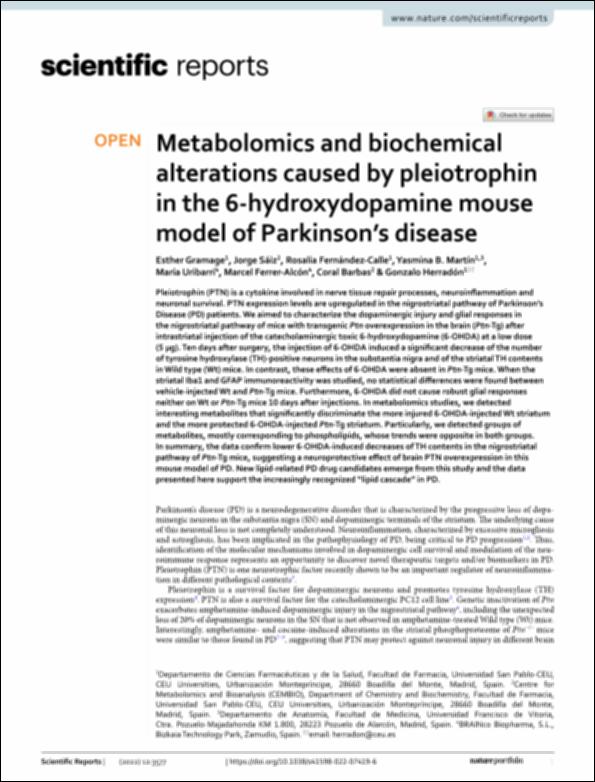Please use this identifier to cite or link to this item:
http://hdl.handle.net/10637/15213Metabolomics and biochemical alterations caused by pleiotrophin in the 6‑hydroxydopamine mouse model of Parkinson’s disease
| Title: | Metabolomics and biochemical alterations caused by pleiotrophin in the 6‑hydroxydopamine mouse model of Parkinson’s disease |
| Authors : | Gramage, Esther Sáiz Galindo, Jorge Fernández Calle, Rosalía Martín, Yasmina B. Uribarri, María Ferrer Alcón, Marcel Barbas Arribas, Coral. Herradón Gil-Gallardo, Gonzalo |
| Keywords: | Parkinson’s disease; Pleiotrophin |
| Publisher: | Nature Research |
| Citation: | Gramage E, Sáiz J, Fernández-Calle R, Martín YB, Uribarri M, Ferrer-Alcón M, et al. Metabolomics and biochemical alterations caused by pleiotrophin in the 6- hydroxydopamine mouse model of Parkinson’s disease [Internet]. Vol. 12, Scientific Reports. 2022. |
| Abstract: | Pleiotrophin (PTN) is a cytokine involved in nerve tissue repair processes, neuroinflammation and neuronal survival. PTN expression levels are upregulated in the nigrostriatal pathway of Parkinson’s Disease (PD) patients. We aimed to characterize the dopaminergic injury and glial responses in the nigrostriatal pathway of mice with transgenic Ptn overexpression in the brain (Ptn-Tg) after intrastriatal injection of the catecholaminergic toxic 6-hydroxydopamine (6-OHDA) at a low dose (5 μg). Ten days after surgery, the injection of 6-OHDA induced a significant decrease of the number of tyrosine hydroxylase (TH)-positive neurons in the substantia nigra and of the striatal TH contents in Wild type (Wt) mice. In contrast, these effects of 6-OHDA were absent in Ptn-Tg mice. When the striatal Iba1 and GFAP immunoreactivity was studied, no statistical differences were found between vehicle-injected Wt and Ptn-Tg mice. Furthermore, 6-OHDA did not cause robust glial responses neither on Wt or Ptn-Tg mice 10 days after injections. In metabolomics studies, we detected interesting metabolites that significantly discriminate the more injured 6-OHDA-injected Wt striatum and the more protected 6-OHDA-injected Ptn-Tg striatum. Particularly, we detected groups of metabolites, mostly corresponding to phospholipids, whose trends were opposite in both groups. In summary, the data confirm lower 6-OHDA-induced decreases of TH contents in the nigrostriatal pathway of Ptn-Tg mice, suggesting a neuroprotective effect of brain PTN overexpression in this mouse model of PD. New lipid-related PD drug candidates emerge from this study and the data presented here support the increasingly recognized “lipid cascade” in PD. |
| URI: | http://hdl.handle.net/10637/15213 |
| Rights : | http://creativecommons.org/licenses/by/4.0/deed.es OpenAccess |
| ISSN: | 2045-2322 |
| Issue Date: | 4-Mar-2022 |
| Center : | Universidad San Pablo-CEU |
| Appears in Collections: | Facultad de Farmacia |
Items in DSpace are protected by copyright, with all rights reserved, unless otherwise indicated.


